Key takeaways:
- Pho is a flavorful Vietnamese dish with deep cultural significance, representing connections through shared experiences and memories.
- The origin of pho reflects a fusion of French influences and local traditions, evolving as a symbol of resilience during Vietnam’s challenging times.
- Authentic pho requires key ingredients like a richly flavored broth, rice noodles, and fresh herbs, with careful cooking techniques to enhance the dish.
- Cooking pho is a communal experience that fosters connection and joy, as friends and family customize their bowls together, creating memorable moments.
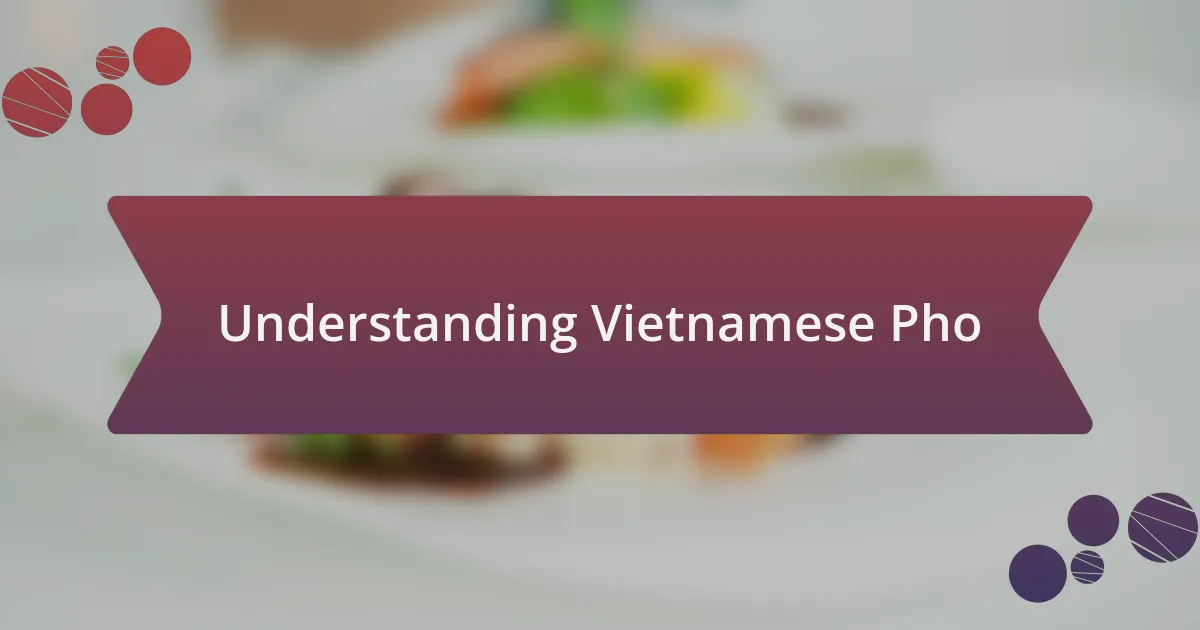
Understanding Vietnamese Pho
Understanding Vietnamese pho is like uncovering a beautiful tapestry woven with flavors, traditions, and stories. When I first tried pho at a small neighborhood restaurant, the aromatic broth enveloped me like a warm hug, and I realized it was more than just a soup; it was a connection to culture.
Pho is typically made with beef or chicken, simmered for hours to create a deeply flavorful broth. Have you ever wondered how something so simple can evoke such strong emotions? For me, the first sip of hot, rich broth transports me back to that cozy eatery, reminding me of family gatherings and hearty conversations.
The layers of ingredients in pho reflect Vietnam’s culinary heritage, from the fresh herbs to the delicate rice noodles. It’s fascinating to think about how each bowl of pho tells a story—every ingredient contributing to a narrative of love and care. Isn’t it incredible how food can bridge experiences and memories, creating a shared appreciation for something as simple as a bowl of soup?
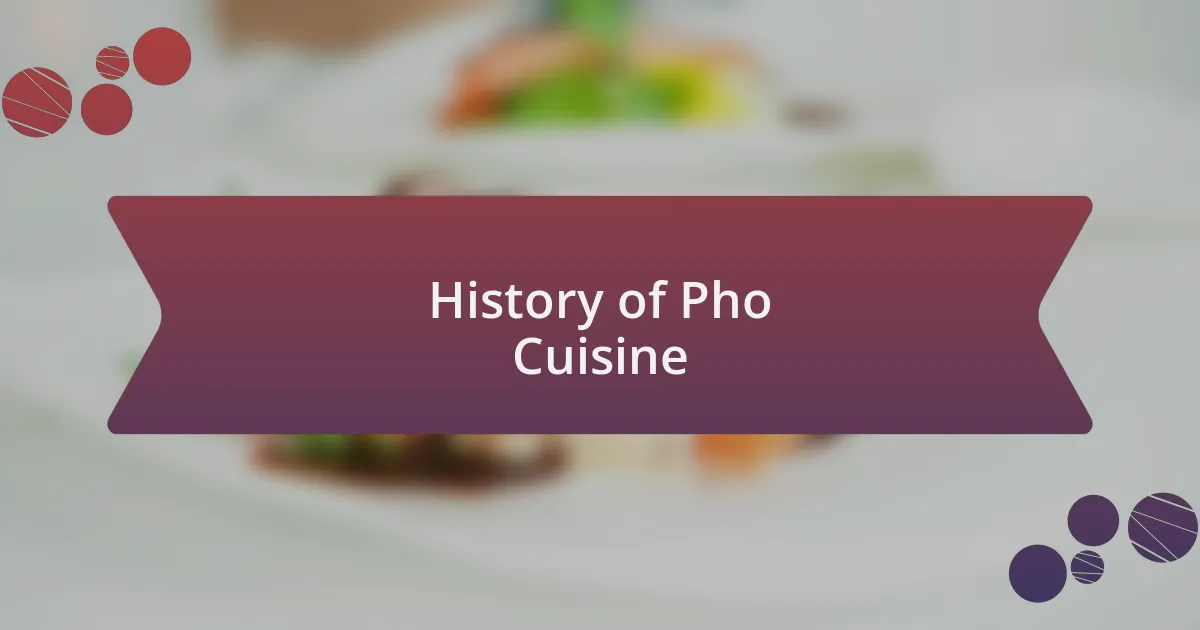
History of Pho Cuisine
The history of pho is a journey through Vietnam’s past, with origins that are often debated among food enthusiasts. Some suggest that pho emerged in the early 20th century in northern Vietnam as a fusion of French colonial influences and local ingredients. I remember sitting with friends over steaming bowls of pho, discussing how the French brought certain cooking techniques and even beef to Vietnam, which find their way into this beloved dish.
As I dug deeper into this culinary exploration, I discovered that pho is not just a food; it reflects the Vietnamese people’s resilience and adaptability through challenging times. During the wars, the simplicity of pho allowed families to nourish themselves with whatever ingredients they could source. I often reflect on how food becomes a comforting symbol in turbulent times; it brings people together, forging bonds over shared experiences, just like my family gathering around the table for a bowl of pho.
Moreover, pho’s significance has evolved beyond regional boundaries—today, it’s a global sensation, embraced worldwide, bringing a taste of Vietnamese culture to diverse palates. Thinking back to my own travels, I recall visiting a street vendor in Ho Chi Minh City, the enchanting aroma drawing me in. It made me realize that with each bowl of pho served, people are sharing a piece of their history, offering not just a meal, but a connection to their culture and heritage.
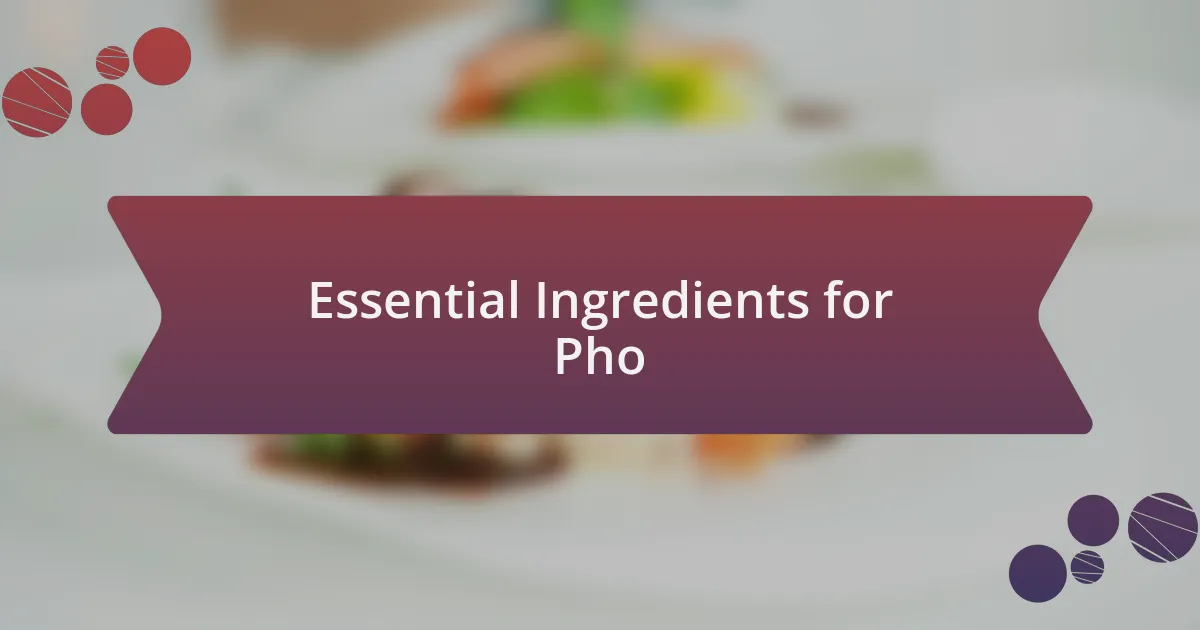
Essential Ingredients for Pho
To create an authentic bowl of pho, a few essential ingredients stand out. The broth is the heart of pho; it requires a thoughtful blend of beef bones, onion, and spices like star anise and cinnamon. I still remember the first time I simmered a pot of broth for hours. The tantalizing aroma that filled my kitchen was an experience that I can only describe as pure joy.
Rice noodles, or banh pho, add that delightful texture that soothes the soul. I often find myself admiring the way they gracefully soak up the flavors of the broth. Have you ever watched the noodles swirl around in the steaming bowl? It’s almost mesmerizing, and it’s this interplay of ingredients that makes every spoonful a little adventure.
Lastly, the toppings bring pho to life: fresh herbs like basil, cilantro, and bean sprouts are essential. I vividly recall a rainy afternoon when I topped my pho with a handful of greens, adding a splash of color and a burst of flavor to each bite. These elements don’t just enhance the taste; they create a vivid canvas of flavors and experiences that remind me why pho holds such a special place in my heart.
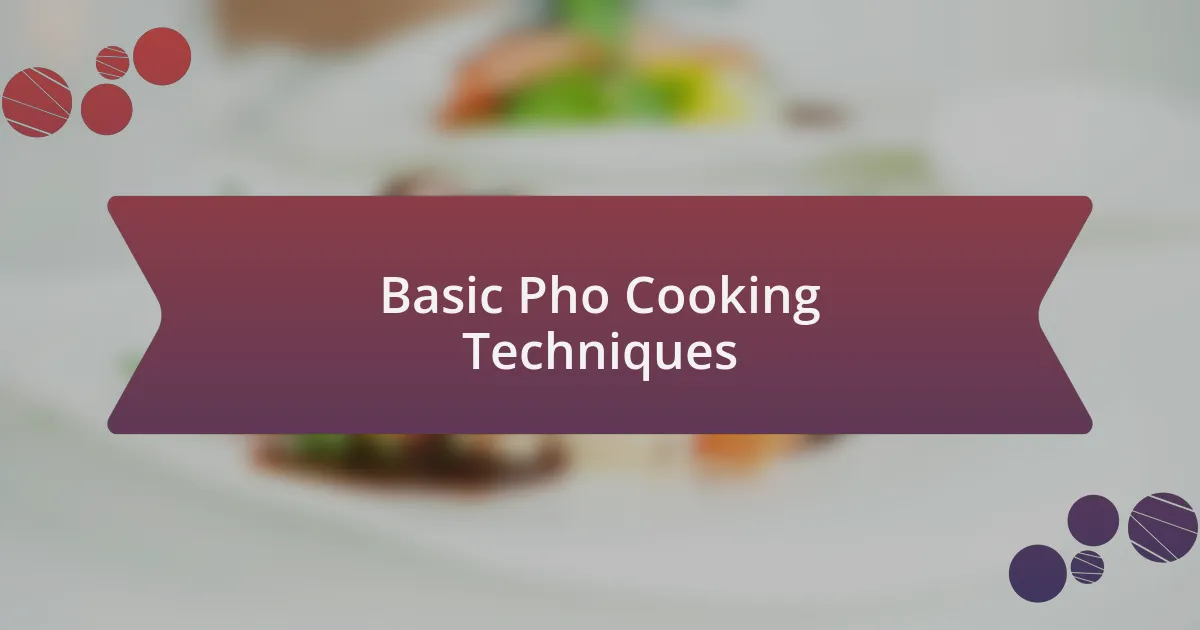
Basic Pho Cooking Techniques
When it comes to making pho, mastering the art of broth preparation is crucial. Simmering beef bones for several hours is not just about cooking; it’s about patience and dedication. I can still hear my grandmother’s voice reminding me to never rush the process. The longer the bones simmer, the richer the flavors become—have you ever tasted a broth so deep that it embraced your soul?
Next, the rice noodles require specific attention. It’s fascinating how simply soaking them in hot water transforms them into the perfect complement to your broth. I recall the first time I misjudged the soaking time and ended up with a mushy mess. The lesson? Consistency is key! Once you get the timing right, watching those noodles glide into the bowl is a sight that brings pure satisfaction.
Finally, let’s talk about garnishing. Adding fresh herbs and other toppings isn’t just an afterthought; it’s an essential step that brightens the entire dish. I vividly remember the thrill of picking fresh herbs from my garden just before serving. The aroma filled my kitchen, making my mouth water. Toppings like lime or sliced chili can elevate your pho, creating that perfect balance of flavors. What topping do you find yourself reaching for the most? I always go for an extra squeeze of lime for that zesty kick!
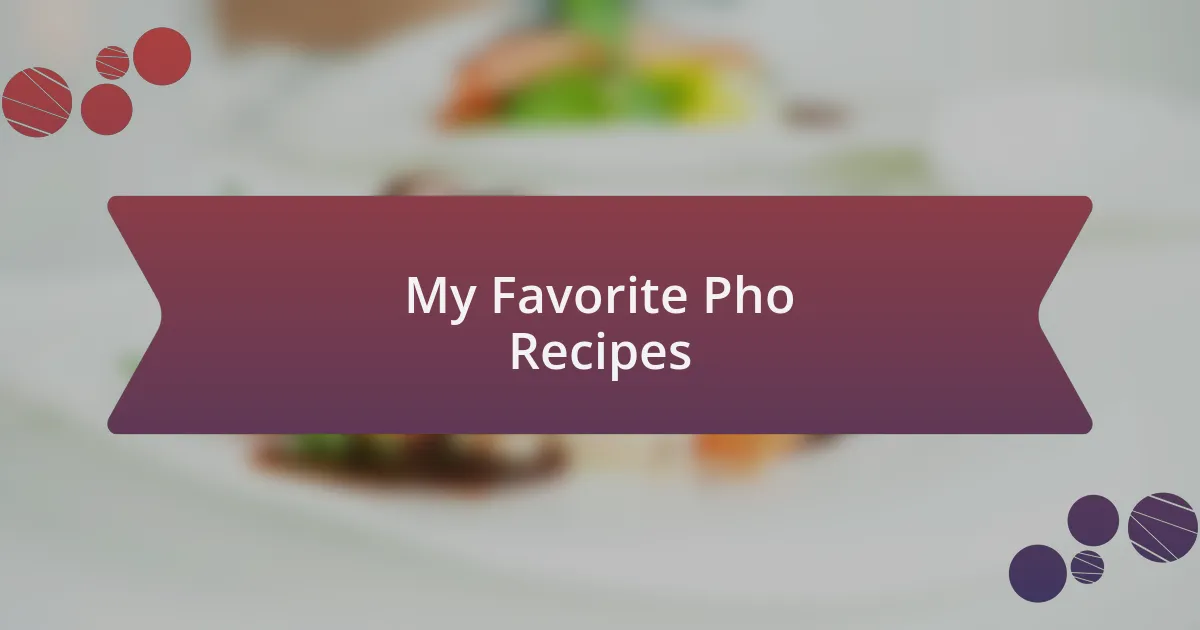
My Favorite Pho Recipes
One of my all-time favorite pho recipes is a simple yet satisfying beef pho, known as Pho Bo. I still remember the first time I attempted it for my friends. The aroma wafting through the house was so inviting that they could hardly wait to dig in. Each spoonful, with tender brisket and fragrant herbs, brought us closer as we shared stories over steaming bowls. Have you ever experienced that sense of community that comes from cooking with love?
Another standout is my vegetarian pho, which showcases a mix of mushrooms and fresh vegetables. I was inspired to create this version after a vegetarian friend joined our cooking circle. It was a challenge, but seeing her delight as she enjoyed her bowl was incredibly rewarding. The broth, enriched with miso, had a depth that surprised even the meat lovers at the table—what’s your favorite way to modify traditional recipes to cater to friends?
Lastly, I can’t ignore the spiciness of my chili pho variation. I remember a cold winter night when I wanted something warm and fiery. I added an extra kick with bird’s eye chilies. The combination of heat and the fragrant herbs was like a warm hug on a chilly evening. It was a hit! What secret ingredients do you add to your dishes when you need that comforting touch?
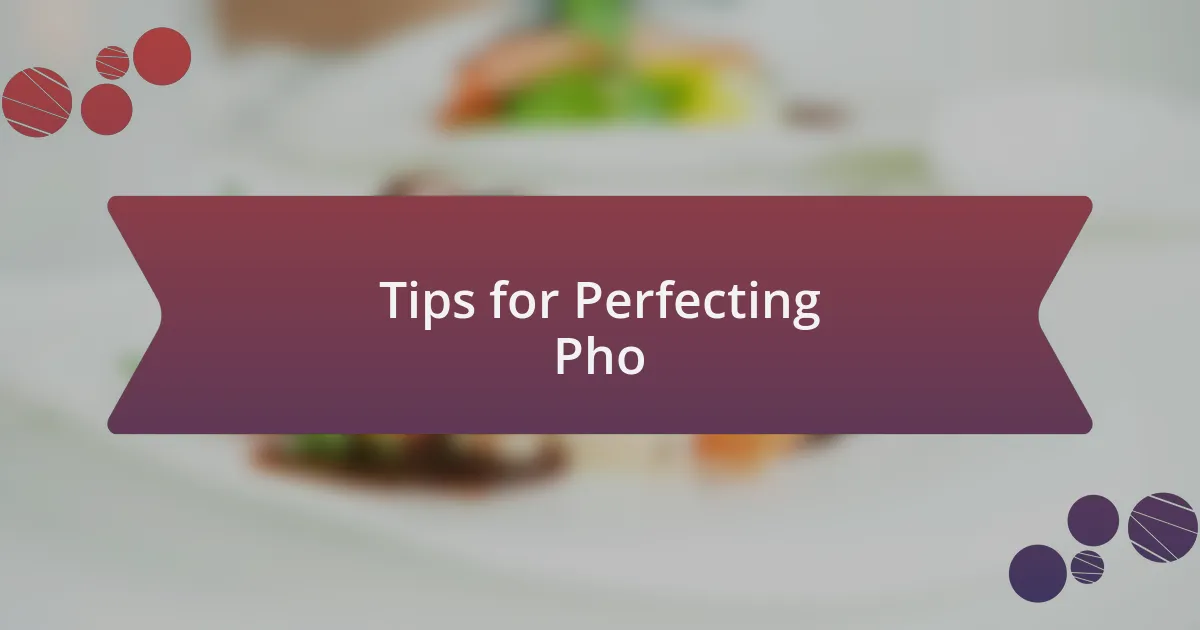
Tips for Perfecting Pho
To truly perfect your pho, the quality of the broth cannot be overstated. I remember my first attempt when I used store-bought stock—I learned the hard way that a homemade broth makes all the difference. Simmering bones for hours releases flavors that pre-packaged versions simply can’t replicate; it’s worth the time for that rich, nuanced taste. What do you think is the heart of any great soup?
Next, the choice of spices is crucial. A well-balanced mix of star anise, cloves, and cinnamon creates that signature aroma. I often find myself experimenting with spice levels, and there was one memorable evening when I accidentally added too much ginger. Instead of ruining the dish, it transformed my pho into a fragrant, zesty delight that left everyone wanting more. Have you had similar happy accidents in your cooking journey?
Finally, don’t overlook the garnishes. Fresh herbs like basil, cilantro, and crunchy bean sprouts elevate the dish from ordinary to extraordinary. I never forget the time I invited my family over and arranged a pho bar with all the toppings. Watching everyone personalize their bowls brought a whole new level of joy to the meal. How do you like to dress up your pho when hosting friends or family?

Personal Pho Cooking Experience
Cooking pho has become a cherished ritual for me. I vividly recall my first time making it from scratch—what a whirlwind of emotions! The moment I pulled the aromatic broth off the stove, a sense of accomplishment washed over me. I wondered, would that satisfying scent be enough to impress my friends who were coming over?
As I prepared my ingredients, I felt a tingle of excitement every time I chopped fresh herbs. I distinctly remember the first time I tried to balance the flavors myself; I was nervous but determined. Adding just the right touch of lime juice felt like an art form, and when I finally tasted it, I couldn’t believe I had created something so delicious. Have you ever experienced that magic when a meal you cooked completely exceeded your expectations?
The process of assembling the pho is where the real fun begins. I love laying out all the ingredients on the table, allowing everyone to customize their bowls. There’s an electric energy in the air as my friends pick their favorite toppings. That communal experience not only elevates the meal but also creates memorable moments. Have you ever noticed how food brings people together in unexpected ways?